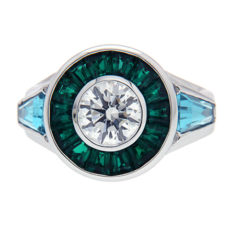Pear-Cut Diamonds: What Are They?
Diamonds are gemstones that
come to mind the instant you think of getting engaged or taking your vows.
However, that does not mean you will have to be content with the traditional
round diamond. You will be astounded to find multiple fancy shapes available at
the best retail shops and online. You are likely to be attracted instantly by
the beautiful pear cut diamonds that
look elegant and make your fingers appear longer.
You would be intrigued to
hear it being referred to as the teardrop diamond as well. True, this shape
resembles a teardrop as much as a pear. The silhouette of a pear diamond ring
is gorgeous. It combines the round and marquise cuts successfully, making it
stand apart from other cuts of a diamond.
History
Trace the history of this
stunner of a diamond, and you will be surprised to learn that this cut is not
entirely modern. The pointed end and a rounded bottom can be traced back to
1458 when the Flemish jeweler, Lodewyk van Berquem succeeded in creating this
magnificent cut. Well, this jeweler par excellence believed in the symmetry of
diamonds. He realized that the facets must allow maximum reflection of light,
contributing to the brilliance of the stone. It is amazing to note that this
concept came to the mind of Lodewyk a century before the birth of the
first-round brilliant cut. Lodewyk utilized the polishing equipment, Scaife to
come up with pear-cut diamonds.
Importance of the shape
The pear-shaped diamond is a
fancy cut. In other words, its shape is not similar to the traditional
round-shaped diamond. You will be fascinated to see it resemble a drop of tear
when you look at it from the top. Its bottom edge appears to be a trifle
rounded, however. The top end is more like a Marquise cut. The combination has
resulted in this unique shape that has achieved unprecedented popularity.
Carat Weight & Ratio
The length-to-width ratio of
a pear cut diamond contributes much to its shape. You would be well advised to
go for a ratio of 1:1.50 to 1:1.75 to make it appear like a teardrop. A bigger
length will make the diamond appear too narrow, and greater width will make it
appear stout and thick. However, a polisher can remove the inclusions by making
them look a bit elongated. Similarly, a diamond cutter can widen the ratio just
a wee bit and succeed in adding to the carat weight.
You may get the look right
by opting for a 1:1.40 ratio when you want to use the pear-cut diamonds in a pair of earrings.
Settle for the aforementioned ratio in an engagement eternity ring. However, a
ratio of 1:2 adds to the harm of a necklace and/or pendant.
You have to be fastidious
about looking at the color when you are eager to source pear-cut diamonds. Remember that this shape holds
a mote color, and a colorless diamond will appear yellowish when cut as a
pear.

Comments
Post a Comment